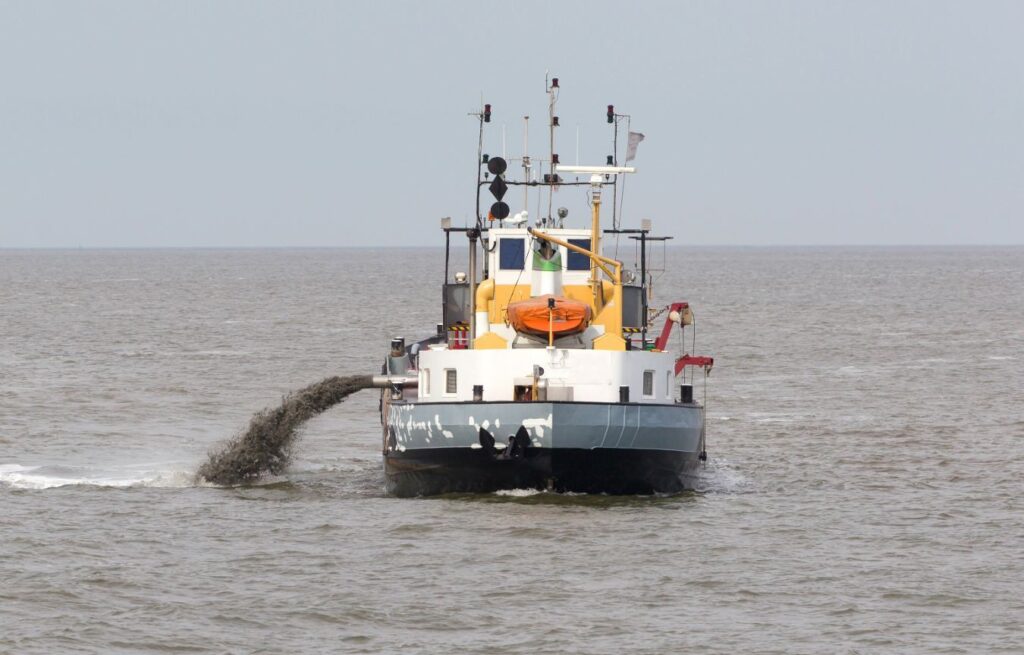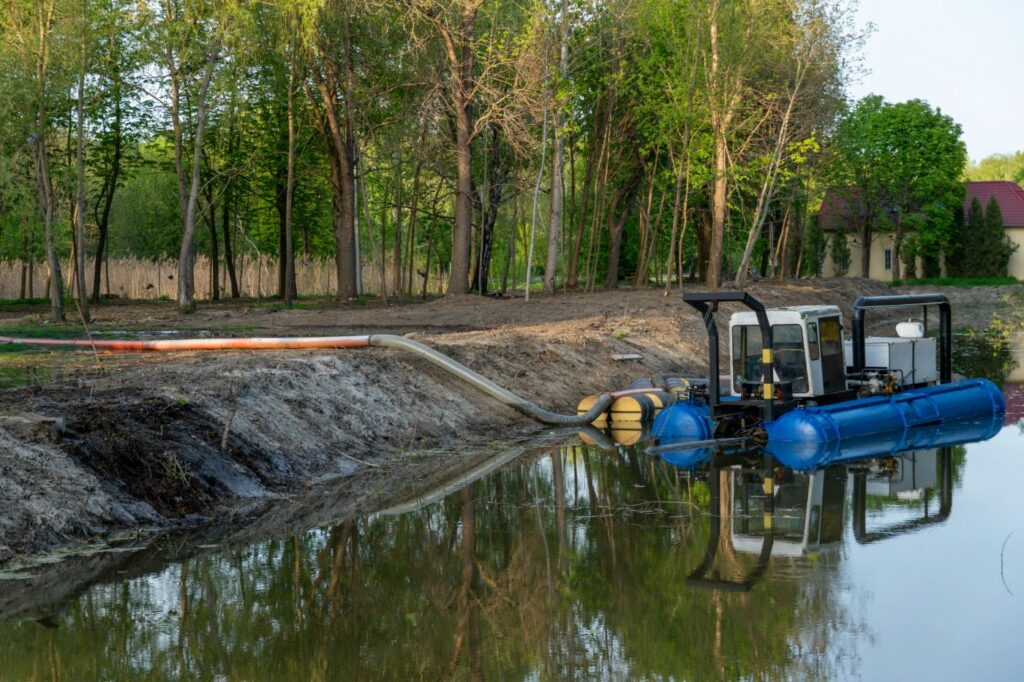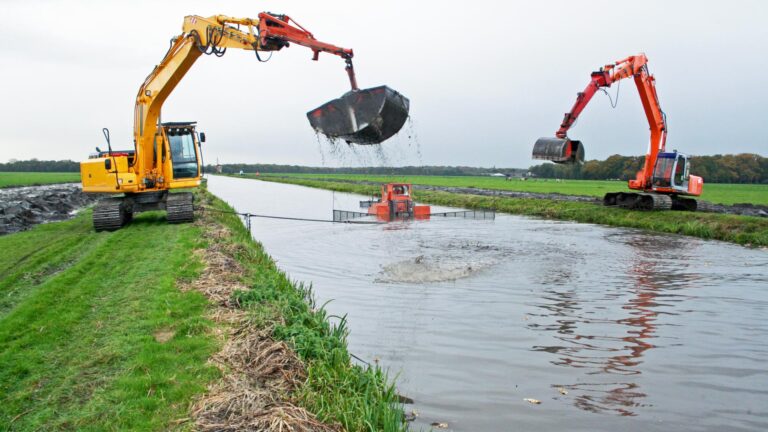Book Appointment Now

What Is a Dredging Pump? Types, Applications, and How It Works
A dredging pump is a specialized type of pump designed to move a mixture of water and solids such as sand, silt, mud, and gravel. It plays a central role in dredging operations by facilitating the efficient transport of sediment from underwater or low-lying areas to designated discharge points. Whether it’s deepening a shipping channel, restoring a lagoon, or reclaiming land, the dredge pump is at the heart of the sediment removal process.
As part of the broader system of dredging equipment, the pump works in tandem with other tools such as cutters, suction heads, and booster stations to ensure optimal performance and productivity. One of its most common pairings is with a dredging excavator, which helps agitate or dislodge compacted material for easier suction and transport by the pump.
Mounted directly on a dredging excavator or installed on barges, pontoons, or floating platforms, the dredge pump transforms heavy-duty machinery into versatile, mobile sediment removal systems. In this blog, we’ll break down the different types of dredge pumps, explain how they work, and explore the industries and applications where they make the most impact. Whether you’re planning a dredging project or upgrading equipment, this guide will give you a comprehensive overview.
What Is a Dredging Pump?
A dredge pump is a heavy-duty pump specifically engineered for transporting mixtures of water and solid particles such as sand, silt, mud, and gravel. These pumps are a fundamental part of dredging operations, acting as the main mechanism for extracting and transferring sediment from underwater or semi-submerged environments. Unlike standard pumps, a dredging pump is designed to handle abrasive materials and high solid content, making it ideal for harsh marine, river, and industrial dredging tasks.
The key components of a dredge pump include an impeller, pump casing, shaft, and either a motor or hydraulic power system. The impeller generates centrifugal force to create suction at the inlet and pressure at the outlet, moving the slurry through pipelines efficiently. The casing houses the impeller and guides the flow, while the shaft connects the impeller to the drive source, which can be an electric motor or a hydraulic system, especially when used with mobile dredging equipment.
What sets a dredging pump apart from a standard slurry pump is its higher resistance to abrasion, ability to handle larger solids, and structural reinforcement to withstand heavy-duty applications. While slurry pumps are suitable for industrial processes with fluid-solid mixtures, dredge pumps are optimized for extreme sediment-laden environments like riverbeds, lagoons, ports, and reservoirs.
These pumps are commonly integrated into larger dredging equipment systems, such as cutter suction dredgers, pontoon-mounted dredgers, and amphibious platforms. One of the most versatile configurations involves mounting a dredging pump on a dredging excavator, allowing operators to reach confined or shallow areas where conventional dredgers cannot operate effectively. This integration transforms an excavator into a powerful sediment removal tool capable of working in swamps, coastal zones, and inland waterways.
As a core component of modern dredge equipment, the dredge pump enables efficient material removal and transport, reducing project timelines and increasing operational productivity across a wide range of industries and environments.
How Does a Dredging Pump Work?

A dredge pump works on the fundamental principle of centrifugal force to move a slurry mixture—typically made up of water and solid materials like sand, silt, or gravel—from one location to another. This process is crucial in dredging operations, where large volumes of sediment must be removed and relocated efficiently.
At the heart of a dredge pump is a rotating impeller. As the impeller spins at high speed, it generates centrifugal force that reduces pressure at the pump inlet, creating suction. This suction draws the slurry into the pump casing. The impeller then accelerates the slurry outward toward the discharge outlet, where it is forced through pipelines to the desired location, whether that’s a containment area, barge, or disposal site.
Here is a simplified step-by-step breakdown of the suction and discharge process:
- Slurry Inflow: The dredging pump inlet is submerged into the slurry, either through a suction pipe or directly mounted on a dredging excavator or floating dredging equipment.
- Suction Generation: The rotating impeller creates a low-pressure zone, drawing the mixture into the pump.
- Slurry Acceleration: Centrifugal force generated by the impeller increases the velocity and pressure of the slurry.
- Discharge: The slurry exits through the discharge outlet and travels through pipelines to the final discharge point.
Several key factors influence the efficiency of a dredging pump. Net Positive Suction Head (NPSH) is critical to prevent cavitation, which can damage the pump. The total dynamic head and flow rate determine how far and how fast the slurry can be moved. Pipe friction, sediment type, and elevation differences also play significant roles.
In practical applications, a dredge pump is often mounted on a dredge excavator, transforming the machine into a high-powered dredging unit capable of reaching challenging, shallow, or marshy areas. In larger-scale operations, cutter suction dredges use these pumps in conjunction with mechanical cutting heads to loosen compacted materials before pumping.
Whether mounted on a mobile dredging excavator or integrated into large-scale dredging equipment, the dredging pump ensures high-capacity, continuous sediment transport in demanding environments.
Types of Dredging Pumps
Dredging pumps come in various designs, each tailored for specific environments and methods of deployment. Choosing the right type depends on the nature of the sediment, the working conditions, and the equipment used. Below are the most commonly used types of dredge pumps and how they integrate with different dredging equipment.
Submersible Dredging Pump
A submersible pump is fully submerged in the fluid it is pumping. This design is ideal for deep or hard-to-reach areas where traditional suction lines might not be effective. These pumps are compact, highly durable, and capable of handling abrasive materials with high solid content. They are frequently mounted on a dredging excavator, allowing operators to dredge directly from ponds, rivers, or swampy terrains. This configuration provides enhanced mobility and access to confined or shallow environments, making it a preferred choice for wetland restoration, environmental cleanup, and mining operations.
Centrifugal Dredging Pump
The centrifugal pump is the most common type used in dredging applications. It operates by spinning an impeller to create centrifugal force, which moves the slurry through pipelines. This type of pump is a staple in cutter suction dredgers due to its ability to handle large volumes of slurry and solid materials efficiently. Its rugged design and high throughput make it a core component of heavy-duty dredging equipment used in port maintenance, channel deepening, and reclamation projects.
Hydraulic Dredging Pump
Hydraulic pumps are powered by hydraulic motors, making them ideal for mobile or amphibious dredge equipment. These pumps offer a compact and flexible setup, often mounted on dredging excavators operating in remote or hard-to-access areas. They’re commonly used in barge-mounted dredging systems or amphibious excavators where electric power may not be feasible.
Electric-Driven Dredging Pump
Electric-driven pumps offer a cleaner and quieter alternative to hydraulic or diesel-powered units. These are typically used in industrial or automated dredging operations, especially where environmental regulations are strict. Often paired with remote-controlled dredging equipment, they are suited for applications such as wastewater treatment, industrial lagoons, or precision dredging in urban areas.
Each of these pump types plays a crucial role when integrated with the appropriate dredge equipment, whether it’s a stationary dredger or a versatile dredge excavator.
Applications of Dredging Pumps Across Industries

Dredging pumps are essential tools across a wide range of industries that require the efficient removal, transfer, or relocation of sediment, sludge, or solids. Their robust design and versatility make them suitable for both large-scale and precision applications, especially when paired with the right dredging equipment or mounted on a dredging excavator. Below are some of the most common industrial uses of dredge pumps:
Marine and Port Maintenance
In ports and harbors, dredging pumps are used to deepen navigation channels, maintain berth depths, and remove silt buildup that can hinder vessel operations. Integrated into cutter suction dredgers or floating dredging equipment, these pumps ensure smooth marine traffic and operational safety. Dredging excavators equipped with submersible pumps can also reach confined harbor corners where larger dredgers cannot operate.
Mining and Mineral Processing
In mining operations, dredge pumps are frequently used to reclaim tailings ponds, transport mineral-rich slurry, and clear sediment from holding basins. Mounted on mobile dredge equipment, these pumps handle abrasive and dense mixtures efficiently. A dredge excavator can also access tailings dams or remote ponds with minimal setup.
Construction Projects
For civil and infrastructure projects, dredging pumps support site dewatering, trench excavation, and land reclamation. Whether used for lowering groundwater levels or moving sediment for foundation preparation, these pumps ensure timelines are met and work zones stay dry. Dredge excavators with hydraulic pumps are particularly useful in swampy or flood-prone sites.
Municipal and Environmental Work
Municipalities use dredging pumps for cleaning reservoirs, restoring lakes and rivers, and removing sludge from wastewater treatment plants. In environmental remediation, they help remove contaminated sediments without disturbing surrounding ecosystems. Lightweight dredging equipment allows for precise work in delicate areas, while amphibious dredging excavators offer unmatched access to soft terrains.
Oil & Gas Industry
Offshore platforms rely on dredge pumps for seabed leveling, pipeline trenching, and clearing debris around structures. These operations demand powerful, corrosion-resistant pumps integrated with rugged dredging equipment. Remote-controlled dredging excavators are also deployed for maintenance tasks in shallow offshore zones.
From urban infrastructure to offshore energy, dredge pumps continue to power sediment management in some of the world’s most demanding environments.
How to Choose the Right Dredging Pump

Selecting the right dredging pump is critical for ensuring efficient, cost-effective sediment removal. The wrong choice can lead to equipment damage, reduced performance, and increased downtime. To make the best decision, several key factors should be evaluated based on your project’s specific requirements and the type of dredge equipment being used.
1. Fluid Type and Composition
Start by analyzing the type of material you’ll be pumping. Is it a watery slurry, thick sludge, abrasive sand, or a mix of gravel and organic debris? Different dredge pumps are designed to handle varying viscosities and solid contents. A pump that works well for fine silt may struggle with large rocks or dense sludge.
2. Flow Rate and Discharge Distance
Understand your required flow rate (typically measured in gallons per minute or cubic meters per hour) and how far the slurry needs to be transported. High head conditions or long pipeline distances may require a more powerful centrifugal dredging pump or the use of booster stations.
3. Solids Handling Capacity
Examine the maximum particle size the pump can handle. If your project involves large debris or coarse sediment, choose a pump with a wide impeller passage and anti-clogging features to maintain consistent flow and reduce wear.
4. Compatibility with Dredging Equipment
Ensure the dredge pump is compatible with your existing dredge equipment, whether it’s mounted on a barge, dredger, or dredging excavator. For mobile operations, a submersible or hydraulic pump is often best, while stationary setups may benefit from electric-driven systems.
5. Power Source
Choose a pump that aligns with your available power supply. Diesel-powered pumps are robust and portable, while electric pumps are energy-efficient and environmentally friendly. Hydraulic pumps are often preferred for dredge excavators due to their compactness and flexibility.
6. Portability and Mobility
For operations in wetlands, shallow waters, or swampy areas, mobility is essential. Pumps mounted on a dredging excavator offer flexibility and access to hard-to-reach locations. Look for lightweight, rugged models designed for easy transportation and quick deployment.
By evaluating these factors, you can select a dredge pump that maximizes performance while minimizing maintenance and operational costs.
Conclusion
Dredging pumps are at the heart of efficient and effective sediment removal, offering the power and durability needed to handle challenging environments and materials. From maintaining port depth to reclaiming land and cleaning tailings ponds, these pumps are essential across various industries. When combined with modern dredging equipment, such as cutter suction dredgers, barges, or a dredging excavator, they deliver unmatched versatility and performance.
Their ability to adapt to different materials, project scales, and operating conditions makes them an indispensable asset in any sediment management operation. Whether you’re working in marine, mining, municipal, or environmental settings, choosing the right dredge pump can significantly improve efficiency and reduce operational costs.
If you’re planning a dredging project, it’s important to assess your specific needs and consult with experienced equipment providers. Contact a trusted dredge pump supplier today or explore integrated pump-dredger packages tailored to your unique application.




